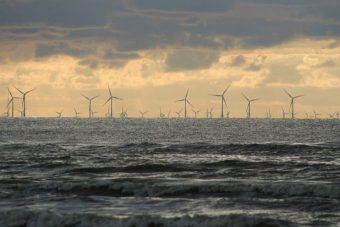
TenneT, the Dutch equivalent of the UK’s National Grid, is thinking about future offshore wind power for a decade or more from now. It proposes to construct a man-made island on Dogger Bank in the middle of the North Sea to act as a distribution hub for electricity generated by a massive offshore wind farm. The island would be used to convert the AC current received from the wind turbines to DC current, which would then be sent via undersea cable to the Netherlands and the UK. Eventually, additional cables could send power to any country bordering the North Sea.
The theory is that by having a main distribution hub in the ocean, power could be sent to wherever it is needed most, maximizing its commercial value because it will always be available to the highest bidder, and minimizing the risk of it not being put to productive use. Offshore wind farm sites in coastal areas are becoming scarce, forcing companies to put turbines further out to sea. But undersea cables are expensive to install and maintain. By plunking an island down halfway between the UK and Europe, the transmission lines could be shorter and therefore less costly. Potential savings could run into billions of dollars.
Rob van der Hage is the manager of offshore wind development for TenneT. He is mildly amused when someone questions whether it is feasible to build a 6 square kilometer island in the middle of the North Sea. “Is it difficult? In the Netherlands, when we see a piece of water we want to build islands or land,” he tells The Guardian. “We’ve been doing that for centuries. That is not the biggest challenge,” he says.
The biggest challenge in whether the economics of the project make enough sense to attract investors. TenneT is prohibited from building power generation facilities. That means it must interest companies like Denmark’s Ørsted, or Germany’s Innogy in participating. Fossil fuel companies like Shell, which is a Dutch company, are beginning to invest in renewables and could be enticed to participate. The island would cost about $1.5 billion. The surrounding wind farms and transmission cables would cost far more than that.
Ultimately, TenneT believes its proposal could generate as much as 30 gigawatts of electricity — twice the amount of installed offshore wind in all of Europe today. The company is putting its plans together and presenting them to potential partners. The video below is part of its initial marketing campaign. Van der Hage says the island could be completed by 2027, at which point construction of the wind turbines would begin.
The idea has gotten a favorable reception from several interested parties. A spokesperson for Germany’s Innogy describes the plan as “very interesting” and National Grid terms it an “innovative design that could play an important role in the long term.” But others remain skeptical.
Peter Atherton, an energy analyst at Cornwall Insight, acknowledges that most of the best near shore sites have already been spoken for, but he is concerned that the power converters TenneT plans to build on its island are costly and rarely used in energy infrastructure. “It’s going to be expensive compared to what they produce locally,” he says. “It sounds a very interesting idea. As the industry matures, you’d very much expect them to start thinking outside the box. Whether the economics pan out, whether you really can sell North Sea wind out to the continent, is questionable.”
Source: cleantechnica.com

